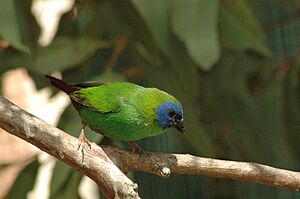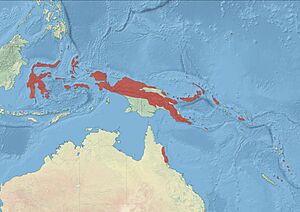Blue-faced parrotfinch facts for kids
Quick facts for kids Blue-faced parrotfinch |
|
|---|---|
 |
|
| Conservation status | |
| Scientific classification | |
| Genus: |
Erythrura
|
| Species: |
trichroa
|
 |
|
| Distribution | |
The blue-faced parrotfinch (Erythrura trichroa) is a colorful bird found in many places around the world. You can spot them in parts of Australia, Japan, Indonesia, and many islands like the Solomon Islands and Vanuatu. They are quite common, living across a huge area of about 10 million square kilometers!
These birds like to live in warm, wet places. They are often found at the edges of forests or in areas where the habitat has been changed, like near farms. They mostly eat seeds from grasses. Experts say these birds are not in danger, so they are classified as a species of "least concern."
Contents
How We Learned About Them
A long time ago, it was hard to spot blue-faced parrotfinches. People didn't have as many ways to observe birds closely. Because of this, they were often missed in early surveys and thought to be rare.
The first blue-faced parrotfinch recorded in North Queensland, Australia was in 1890. This bird was about 12.1 centimeters (4.8 inches) long. Its wings were 6.2 cm (2.4 in), and its tail was 5 cm (2.0 in). This important bird is now kept at the Melbourne Museum. More blue-faced parrotfinches were found in Queensland in the years 1899, 1913, 1914, and 1944.
One special type of blue-faced parrotfinch found in Queensland is called Erythrura trichroa macgillivrayi. We don't know much about its specific numbers or how well it's doing.
What Do They Look Like?
Male blue-faced parrotfinches are very colorful! They have many shades of green, from light yellow-green to dark blue-green. Their face and forehead are a deep, bright blue. Their tails are usually red or a rusty red-brown color. These birds are typically about 13 centimeters (5.1 inches) long.
Female blue-faced parrotfinches are also pretty, but their blue colors are not as bright as the males'. They are usually a little smaller than the males and have slightly more rounded heads.
Birds found in Queensland look very similar to each other. Their feather colors, beak shapes, and even their genes are alike. Scientists think this is because these birds move around a lot. This movement helps keep their groups mixed, so they don't develop big differences.
Where Do They Live?
Blue-faced parrotfinches love the edges of rainforests. They also like dense grasslands that have woody plants, like small trees or bushes. They often sleep or rest in rainforests.
You can find these birds in many different places, from hot tropical islands right by the sea to high mountains in New Guinea, up to 3,000 meters (9,800 feet) high. They move around during different seasons. They are sensitive to cold, so in winter, they might move to warmer, lower areas.
How Do They Behave?
Blue-faced parrotfinches are shy and quiet birds. If they feel threatened, they quickly hide in the grasslands for cover.
What Do They Eat?
Blue-faced parrotfinches mainly eat seeds from grasses and bamboo. They also enjoy small insects and figs. They especially like the seeds of Brachiaria decumbens, also known as Signal Grass. They also eat seeds from Lantana camara (West Indian Lantana) and Panicum maximum (Guinea Grass). They are good at adapting and will eat new food sources if they become available.
These birds usually find their food by sitting on a branch or stem (about 1 meter high) and picking seeds. They don't often climb or peck at the ground. This means they don't compete much for food with other bird species that prefer to climb. Also, blue-faced parrotfinches find food in specific small areas, which helps them share resources with other birds.
You often see blue-faced parrotfinches in small groups, sometimes with 30 or more birds. The more food there is, the larger the groups tend to be.
How Do They Raise Their Young?
Female blue-faced parrotfinches usually lay about four eggs, but sometimes they can lay up to eight. The eggs hatch after about 15 days of incubation. The female does most of the sitting on the eggs to keep them warm.
Once the chicks hatch, the male parrotfinch is in charge of feeding them. The young birds are ready to leave the nest after about 21 days. Even after they leave the nest, their parents continue to feed them for another 10 to 20 days.
Images for kids



